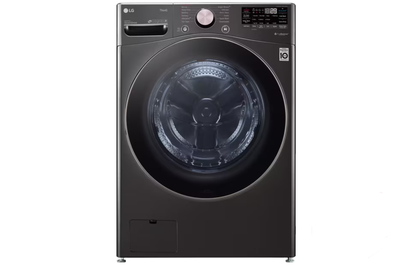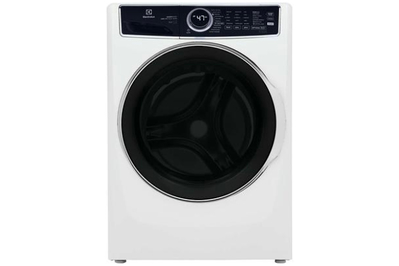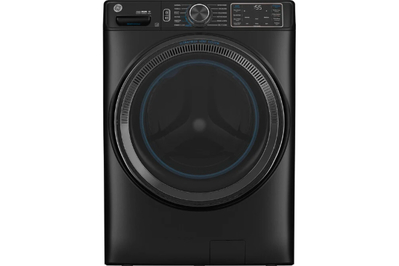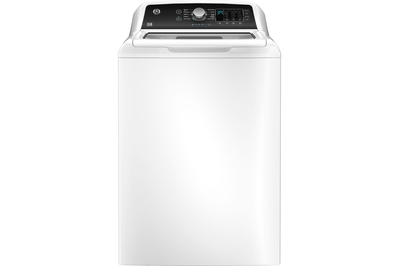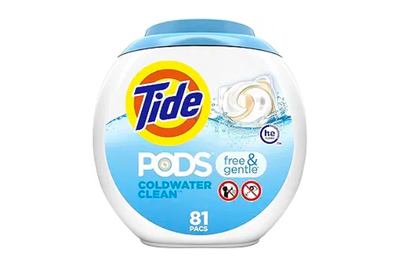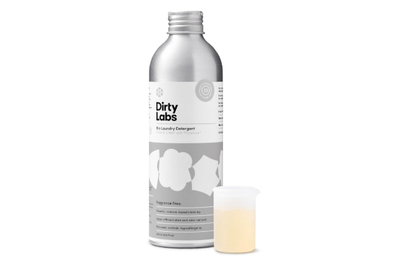
Andrea Barnes is a writer covering large cleaning appliances. She has run more than 120 dishwasher cycles and washed at least 120 loads of laundry.
When we test washing machines, dryers, and laundry detergent, we take laundry day to the next level.
Sure, the process involves plenty of gross stains and funky odors (we recreate the laundry loads of nightmares, complete with aioli, lipstick, used engine oil, and sometimes even dog fur). But dirty laundry is only part of our evaluations. We also put washers, dryers, and detergents through simulations of real-world wash scenarios, conduct industry standards tests, consult experts, and read research papers.
We’ve been evaluating washing machines and their matching dryers since 2013. For our most recent round of testing, we shoveled loads of laundry into 12 washing machines and 12 dryers and put more than 35 laundry detergents to the test. Here’s how we do it all.
We assess stain removal and gentleness

To evaluate a washing machine’s stain-removal power, we adapt an industry-wide test developed by the Association of Home Appliance Manufacturers that involves washing strips of linen pre-stained with red wine, cocoa, pig blood, carbon black (a mixture of mineral oil and soot), and sebum (body oil).
Unless you live with a chimney sweep or a butcher, you’re probably not faced with laundry caked in soot or soaked in pig blood. But by monitoring how much stain is removed from the strip after washing (in both hot and cold water), we get a broad idea of how effectively a washing machine cleans.
To test how gently a washer handles fabric, we run three tests in each machine on both a normal and gentle cycle. The Poka-Dot test uses a fabric swatch covered with tiny, delicate raised dots. Even a slight amount of abrasion causes the dots to fall from the swatch. A rough washing machine detaches many dots; a gentle washer leaves more dots intact.
After the swatch emerges from the wash, we inspect it. An unofficial but telling data point: how many dots we continue to find in the machines.

In addition to the Poka-Dot swatch, we add a piece of loosely woven synthetic plaid fabric to each load and count how many frayed threads emerge when a cycle is done.
Both fabric-care tests, though helpful, present extreme scenarios. To get an idea of potential day-to-day damage on commonly washed clothing, several industry experts suggested we cut 3-inch holes in a swatch of higher-quality cotton fabric, wash it, and count the frayed threads.
We load up laundry
To gain a real-world sense of how each washing machine performs, we assemble a typical, 12-pound laundry load with a mix of clothing, towels, and other items. This helps us see how a washer handles an array of clothing and challenges a dryer’s sensor-based settings. The load includes pants (jeans, slacks, yoga pants, pajamas), shirts (three tees, one button-up), a hoodie, a workout top, a camisole, four pairs of underwear (boxers and briefs), five pairs of socks, and three towels.
Many readers complain that their washing machines can’t handle comforters, or their dryers bunch up sheets. So we wash and dry sheets and a king-size duvet (our top dryer picks consistently delivered evenly dried sheets with no bunching and easily accommodated a duvet).
We wash and dry (and wash and dry again)
When we have all our materials together, we begin testing.
We wash a 12-pound load—along with a stain strip and one of our fabric-care swatches—in each washing machine on a hot and a cold cycle. For each load, we use 2 tablespoons (yup, that’s all you need) of Tide Original liquid detergent.
We weigh each load before and after washing, which helps us determine how much water the spin cycle extracted. Top-performing machines can remove as much as 2 more pounds of water from wet loads than machines with less-powerful spin cycles; this allows the laundry to dry faster and more efficiently.

We scan washed stain strips with a colorimeter, which tells us the color values of each stain panel. For the most part, it is easy to identify which machines clean better without using the colorimeter, but it can help make the final call. Then we assess our fabric-care swatches, noting if the machine was hard on the material.
We wash multiple loads like this, paying close attention to the washer’s available cycles (how many and what types?), control panel (is it intuitive to use?), design (is the door easy to open or reversible?), and detergent dispenser drawer (a good one doesn’t leave residue behind). We also take into account the price and energy efficiency (PDF) of each machine.
After washing, we dry each load in each washer’s matching dryer on its sensor-dry setting (sensors monitor the moisture inside the dryer to determine how long a load should dry). Sometimes we get creative: For one model that had a setting specifically for pet fur, we borrowed laundry from a neighbor who lives with two golden retrievers and a Flemish Giant rabbit to see how it handled lots of fur. We compare the initial estimated drying time with the actual drying time required for each load and note how dry the clothing emerges.
We pay attention to the controls, available cycles, and ease of opening and closing the door. Other details, like the user-friendliness of the lint trap and the dryer’s overall sturdiness (we disqualified one model because the striker—a pin that tells the machine it’s closed—was not aligned with the door), are observed.
After we’ve put a washer and dryer through our tests, we scrutinize our full panel of data and assign each a grade based upon overall performance. The best rise to the top.
Our pick
This speedy and gentle front-loader is excellent at removing all kinds of stains. It has a solid reputation for reliability, but LG’s customer service is not great.
Runner-up
This high-performing front-loader removes stains very well and has an array of specific (and useful) settings. But it doesn’t have as good of a reputation for reliability as our pick does.
Also great
A thorough cleaner, this model manages mold better than the other front-loaders we recommend. But it has longer cycles than our pick and is potentially less reliable.
This top-loader with an agitator cleans well, offers multiple fill options, and has some useful energy-saving features. But some cycles are tough on clothing.
We rinse and repeat to test laundry detergent

As we test washers and dryers, we also test laundry detergents—more than 35 of them in our most recent round, including liquids, powders, pods, and sheets. We focus on detergents that are designed for high-efficiency (HE) washers, which use considerably less water than standard machines (PDF) and contain different combinations of enzymes that gobble up a variety of stains.
To kick off our testing, we stain cotton T-shirts with two sets of the same 12 hard-to-wash stains: grass, tomato sauce, wine, chocolate, a turmeric-infused aioli, motor oil, lipstick, foundation, browned butter, tea, pig blood (yes, again), and blackberry. The stains dry overnight.

Before washing each stained tee, we pretreat one set of stains with a detergent. That T-shirt and one pre-stained test strip (the same we use for washer testing) go into an 8-pound test load. We repeat this for each detergent, washing on a normal cold-water cycle in our top-pick washing machine. (Cold-water washing is best for your fabric and your energy bill. It’s also an excellent way to determine the real stain- and odor-removing power of a detergent.)
We repeat this process for every detergent, taking detailed notes as we go.

We evaluate each T-shirt after it air-dries overnight, paying extra attention to the state of more-commonly encountered stains, such as grass or blood. Then we retest the highest performers. For these elimination rounds, we use our upgrade-pick compact washing machine on a cold, 35-minute cycle. The short cycle gives the detergent less time to wash away stains.

Finally, when we’ve pinpointed the top stain removers, we wash a final load with each finalist. This load includes an industrial stain monitor—a jersey cotton swatch professionally stained with 15 stains, including used engine oil, grass, and red wine—and one of our stained T-shirts dirtied additionally with bacon grease to help us sniff out the best odor eliminators. (We even washed a few loads of a teenager’s funky laundry to determine the winners on that front.) When the results are in, we make our picks.
Happy laundry day.
Our pick
This powerful powder dissolves swiftly (and completely), eliminates tough stains, and leaves a light scent. But it doesn’t clean greasy stains as well as our liquid picks do.
This fragrance- and dye-free liquid was the most well-rounded detergent we tested, tackling a variety of stains and odors well.
Runner-up
This liquid detergent fell among the top performers in stain removal, but its strong scent lingers long after clothes have dried.
Buying Options
With store pickup or free shipping with Walmart+ membership (150 ounces)
Also great
These fragrance-free pods are convenient, strong cleaners. But they don’t have quite the stain-fighting power of our top picks, and you can’t use them to pretreat.
Buying Options
This hyper-concentrated liquid detergent is an effective stain remover, with cleaning power that rivals our top picks. It comes in a reusable aluminum bottle, but it is expensive.
This article was edited by Ingrid Skjong and Courtney Schley.
Mentioned above
- After doing loads (and loads) of laundry in 12 full-size washing machines, we still recommend the LG WM4000H as our top pick.The Best Washing Machines (and Their Matching Dryers)
- We tested dozens of laundry detergents and found that Tide Ultra Oxi Powder and Tide Free & Gentle Liquid tackled the widest range of stains with ease.The Best Laundry Detergent
- Of the compact washer and dryer sets we considered, our pick has all the important features we like at a more affordable price.The Best Compact Washer and Dryer
Further reading
How to Clean a Dog Bed
by Kaitlyn Wells
Using a few essentials cat and dog owners are likely to already own, it’s easy to turn a pet bed from a dingy mess into a comfortable hideaway.
What’s the Best Vacuum for Pet Hair?
by Sabine Heinlein
We recommend six vacuums that have the tools, power, and maneuverability to tackle pet fur in your carpets, on your couch, or in your car.
The Best Dryers
by Andrea Barnes and Annie Chou
Most dryers perform pretty similarly. We recommend looking for a simple, reliable, sturdy model with access to parts and a decent warranty.
The New GE Profile Washer-Dryer Combo Is Better Than Most. But We Still Don’t Recommend It.
by Andrea Barnes
The GE Profile UltraFast Combo washer-dryer promises a speedy all-in-one laundry experience, but get ready to majorly adjust your laundry routine if you buy it.

